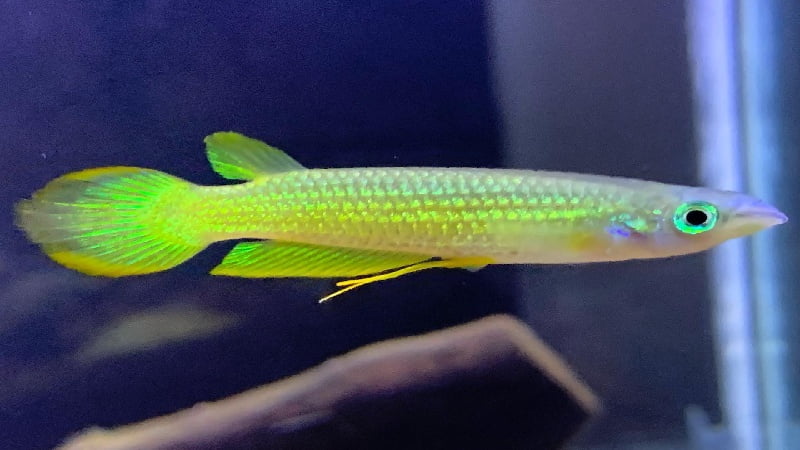The Golden Wonder Killifish is a beautiful and popular fish that can make a great addition to any aquarium. However, before you add one to your tank, it’s important to be aware of the eight basic Golden Wonder Killifish care requirements for keeping a healthy one. You can help ensure your fish stays healthy and happy for years to come by meeting these requirements. So let’s scroll down and explore now!
General Information About Golden Wonder Killifish
The golden wonder killifish is a small, brightly colored fish found in many parts of the world. They are a great fish for beginning aquarists because they are hardy and easy to care for. This section will help you learn basic information about this pet.
Origin And Distribution
Golden Wonder Killifish’s ancestors originated in Asia. Piki, Striped Panchax Killifish, and Malabar Killifish are all common names for the Golden Wonder Killie. They do, however, thrive in all types of aquariums worldwide. They are excellent choices for community aquariums because they offer color and activity to the tanks.
The original tank breeder was Sri Lankan and Indian in origin. The fish are presently found in all continents except Antarctica and Australia in subtropical to tropical seas.
Killifish typically live in temporary swamps, pools, and shallow streams, though they have been known to inhabit brackish estuaries. The majority of killifish inhabit environments with overhanging plants and trees.
Appearance
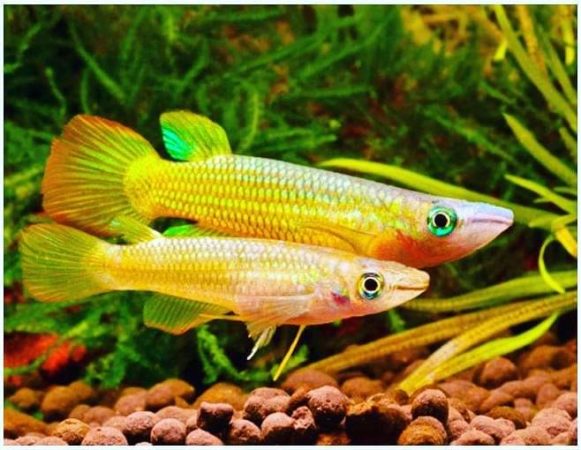
Killifish, like the Golden Wonder, are compact in shape. The length of their body is less than 12 centimeters. A female’s body is 9–10 cm longer than that of a male. They have gray bodies with a slight tint of green or gold, and dark stripes cover most of the upper body.
With the sidelight illuminating the fish, it looks wonderful. An essential feature of the males is their bright green scales. Keeping the lamps near the view glass will allow you to enjoy the beauty of the Golden Wonder Killifish every time you look at them.
The females are distinguished from the males by their gray bodies and yellowish fins. In addition, the females’ body is covered in shiny scales.
Temperament & Behavior
Although the Golden Wonder Killie is a primarily calm fish, males can occasionally be abrasive and possessive toward one another. Numerous species may be easily kept in community aquariums, but you must follow some guidelines.
Because this type of killifish is extremely predacious and would eat any smaller tankmates without hesitation. It is prudent to keep them with larger and different fish to avoid difficulties in your aquarium. Take care when handling little fish. They are edible to the Golden Wonder Killifish.
Size & Lifespan
A fully-grown Golden Wonder Killifish can reach a size of approximately 4 inches or 10 cm in their natural habitats. The fry in the aquarium will have grown to 7.5 cm, or approximately 3 inches long in aquarium captivity, an excellent and average size for purchasing fish.
When given the proper care and living conditions in a captivity environment, Golden Wonder Killifish are likely to live up to 4 years. No matter how closely you recreate the fish’s natural habitat in captivity, they won’t get the natural conditions that nature gives them, which means they won’t live as long as other fish varieties. Golden Wonder Killifish live approximately five years longer than their captivity breed counterparts.
Golden Wonder Killifish Care: The Ultimate Guideline
Caring for a Golden Wonder Killifish is not as difficult as it may seem. This article will provide you with eight basic requirements for a healthy fish. By following these guidelines, you can be sure that your fish will live a long and prosperous life.
Tank Size
The Golden Wonder Killifish prefers a tank with a minimum capacity of 20 gallons. Because these Killifish species always inhabit the tank’s upper layers, you might select a tank with more conditions to provide them with additional exploration room. However, you do not need to have deeper tanks for them if you do not want to grow any plants.
We would suggest you consider a 30-gallon tank since you will be housing more Golden Wonder Killifish. Additionally, a large tank allows your fish greater freedom to explore and thrive.
Tank Setup
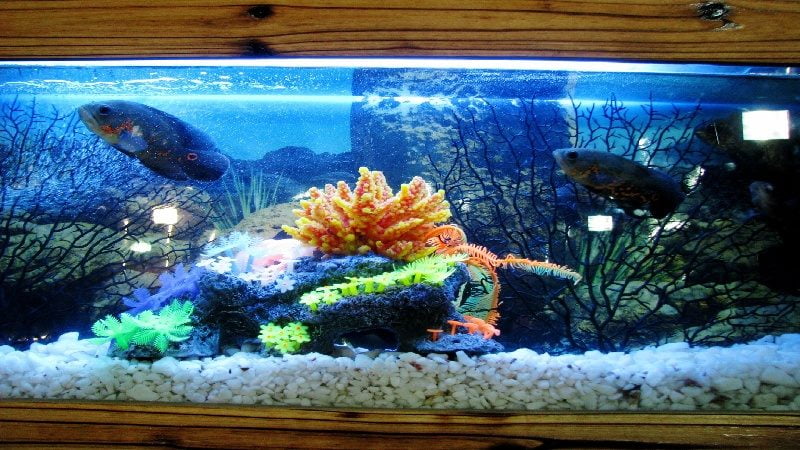
An aquatic plant-rich forest with quiet water is the ideal habitat for this resistant fish species. These fish do well with Floating Aquarium Plants, so keep an eye out for those.
Because of their height, they are an excellent choice for establishing a wooded habitat for fish. However, because they are predators, they don’t give a damn about a plant’s structure.
A tight-fitting lid and cover slides that keep the fish within the tank are essential because they’re excellent jumpers. In addition, an aquarium should include dark and sandy substrate as well as decorations that offer shelter like driftwood tangle, rocky outcrop, and cave to make the tank more appealing to fish.
Lighting in a Killifish tank should be subdued so that the viewer may fully appreciate the fish’s innate beauty. Gold Wonder Killifish prefers changing water conditions. Therefore it is vital to maintain your tank’s water quality. Depending on the size of your tank aquarium, you should use the proper aquarium filtration system.
It is advisable to conduct changes twice a week for at least thirty percent (30%). A gentle flow of water is beneficial to fish. So, make adjustments to the filtration process or use tall planting or rocky outcrops to baffle the water.
In addition, you can regularly remove the uneaten food in the vacuum of the community tank by looking for bottom-feeding scavengers, such as Corydoras Catfish.
Providing filtered light will help replicate their natural habitats. With LED Aquarium Light, you can provide perfect lighting for your fish,
Water Parameters
Gold Wonder Killifish are native to freshwater environments but can survive in brackish water. Add between two and three teaspoons of aquarium salt per 2.5 gallons of water to make it feel brackish.
The fish prefer a temperature between 72 and 82 degrees Fahrenheit. The pH level of the water should be in the range of 6.0 to 7.5 pH, and hardness should be in the range of 5 to 20 dGH.
Changing the water twice a week helps you maintain the new conditions in the tank by implementing high-quality filtration techniques. In addition, it is essential to adjust the filtration accordingly as you allow the water to move slowly in the tank.
Killifish are extremely sensitive to changes in water quality. As a result, the acclimatization process for fish should not be hastened.
Do not feed your fish for the first few hours in their new tank if you recently introduced them.For the first several hours, turn off the tank lights completely to allow the fish to adjust to their new surroundings.
Plants
Some plants on the water surface float, including Dwarf Water Lettuce and Amazon Frogbit, are good food sources for fish. You can also add driftwood tangles, rocky outcrops, and caves for better shade.
Diseases
One of the best examples of a very hardy fish is the Golden Wonder Killifish. Hence, if your aquarium is well-maintained, there is minimal chance of the fish contracting the illness.
There are, however, times when your fish will suffer from velvet and bacterial diseases. Therefore, before adding items to the tank setup, consider thoroughly cleaning or quarantining all of them, like the fish, plants, substrate, invertebrates, and decorations.
Although the fish is resistant to many diseases, outbreaks usually do occur; thus, it is necessary to deal with the disease early on to enhance the quality of the fish. Fish are always susceptible to infection, especially under stressful circumstances.
This requires the utmost care for fish and a suitable environment that minimizes the situation and its complications.
Tank Mates
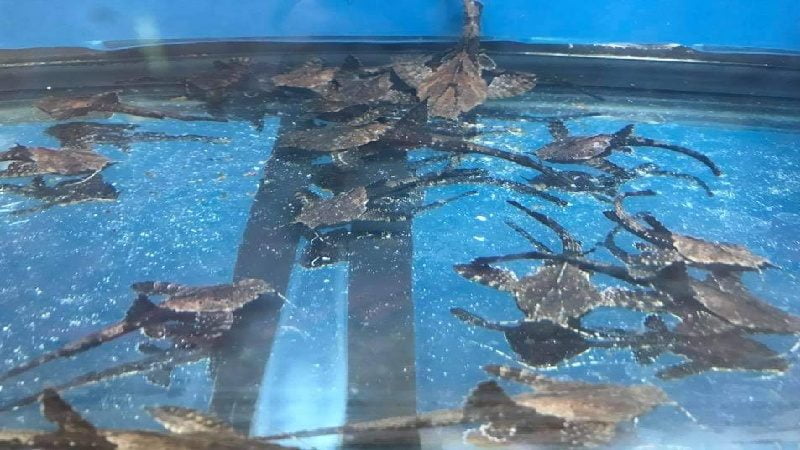
The Golden Wonder Killifish is an incredible communal fish primarily regarded as a peaceful species. On the other hand, Male Golden Wonders may be hostile at times, mainly when competing against females.
2-4 Golden Wonder Killifish are kept together in my tank. The Golden Wonder Killie is thought to be a particularly vicious species. This is the primary reason they should not be kept in communal tanks with smaller fish since they may quickly become the meal.
Any fish of a larger size that is sociable, community-oriented, or tranquil is an excellent tankmate for your Golden Wonder. We can include bigger tetras, rams, Banjo Catfish, Otocinclus, other dwarf cichlids, and the majority of Corydoras Catfish. Additionally, Golden Wonder Killifish may cohabit alongside Vampire Shrimp and snails.
Diet
Like a carnivore fish, Golden Wonder Killie requires frozen food, such as brine shrimp, bloodworms, mosquito larvae, and Mysis shrimp. However, even though they usually reject dry food, it’s worth a try since I’ve tried it, and it works.
The most vital thing to remember when breeding a pair is to feed them live foods, which keeps even the colors vibrant. You should never collect insects or insect larvae from the wild. A wild live food supply is one of the most common ways to introduce disease and parasites to your aquarium.
They require a variety of foods once or twice a day, and it is important that they eat no more than can be consumed in two minutes. Since I have many aquariums, it’s hard to keep track of feeding my fish. An automatic fish feeder can help me keep track of feeding my fish.
Breeding
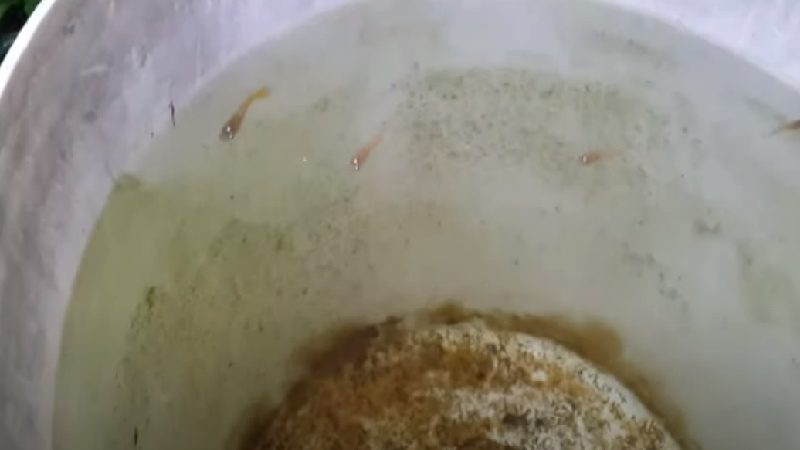
Prior to breeding both sexes, take a close look at the distinct characteristics of each fish. It’s good to have a separate breeding tank for the fry’s protection. If you want a fish specimen for breeding purposes, ensure that the model includes both male and female fish, as the two sexes are clearly distinguishable.
Transfer the pair of well-conditioned fish to the soft water breeding tank. Numerous thick fine-leaved floating plants should be added to the tank. After laying the eggs and successfully fertilizing them, you must consider the safety of the young fry.
Additionally, once the spawning process is complete, remove the parent fish from the tank where the breeding occurred. Depending on the tank temperature, a single spawn produces between 100 and 150 eggs, which hatch in eleven to fourteen days.
A young fry thrives at a temperature of 72-79 degrees Fahrenheit (25-27 degrees Celcius), where they feed on shredded plant material.
Egg sacs usually remain attached to the bellies of newly hatched fish for a few days after they hatch. Then, within a few days, the fish escapes from the sac, and they are free to frolic in the tank.
You may then offer them freshly hatched brine shrimp and finely powdered fry food. These fries grow by eating crushed bloodworms and other small insects in addition to crushed peas. Again, make sure you separate the larger and smaller fish so that there is no cannibalism.
Video: Golden Wonder Panchax Care Guide
FAQs
Can golden wonder killifish eat other kinds of fish?
Yes. It is an excellent illustration of a predator’s willingness to eat anything small enough to fit in its jaws. The fact that Golden Wonder Killifish is a carnivore feeds on the smaller fishes in some situations.
It may consume its young ones and the crustaceans, therefore the necessity for isolation. In turn, it stimulates the living flesh, which makes their color thrive and appear gorgeous.
What is the ideal number of Golden Wonder Killifish to keep together?
Even though Golden Wonders is not a schooling species, you can safely keep up to four individuals together.
What is the price of Golden Wonder Killifish?
The price of the Golden Wonder Killifish varies by species. Then, you can expect to pay a minimum of $1.25 and a maximum of $3.75 for each. You can buy this fish from liveaquaria.com, eBay, etc.
Wrap Up
In conclusion, if you are looking for a low-maintenance, easy to care for fish, the Golden Wonder Killifish may be perfect for you! They only require eight basic things to remain healthy, so they are great for both beginner and experienced aquarists alike. So be sure to give your new pet a try and enjoy watching them thrive in their new home!

Annette M. Chaney is an experienced marine biologist with over 20 years of experience as an aquarist and fishkeeper. She started her first aquarium at a young age, filling it with frogs and goldfish obtained from the ten-cent pet store.
Annette grew up caring for and breeding African Cichlids, which led to a hobby in high school that doubled as a profitable means. Attending Reed College gave her time to solidify herself as an accomplished aquarium caretaker with an eye for sales. After that, from 2009 – 2013, she studied at Roger Williams University – one of the most prestigious universities for Aquaculture and Aquarium in USA. She is the founder of AquariumCircle since 2010.
